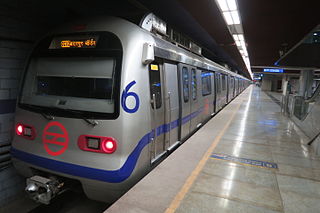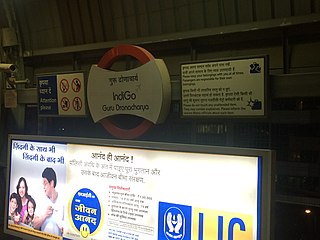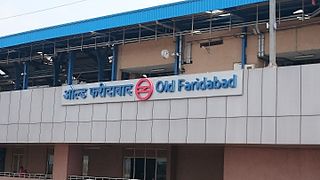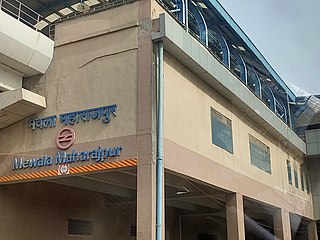
Delhi has significant reliance on its transport infrastructure. The city has developed a highly efficient public transport system with the introduction of the Delhi Metro, which is undergoing a rapid modernization and expansion since 2006. There are 16.6 million registered vehicles in the city as of 30 June 2014, which is the highest in the world among all cities, most of which do not follow any pollution emission norm, while the Delhi metropolitan region has 11.2 million vehicles. Delhi and NCR lose nearly 42 crore man-hours every month while commuting between home and office through public transport, due to the traffic congestion. Therefore, serious efforts, including a number of transport infrastructure projects, are under way to encourage usage of public transport in the city.
The Western Peripheral Expressway (WPE) or Kundli–Manesar–Palwal Expressway, is an operational 6-lane, 135.6 km (84.3 mi)-long Expressway in the Haryana state of India. Along with the Eastern Peripheral Expressway, the Western Peripheral Expressway is expected to divert more than 50,000 heavy vehicles away from Delhi, which will help to maintain good air quality in Delhi. Western Peripheral Expressway along with Eastern Peripheral Expressway completes the largest Ring Road around Delhi. There are 10 tolled entries and exits, from north to south - Kundli, Kharkhoda, Bahadurgarh, Badli, Fartukhnagar, Panchgaon, Manesar, Taoru, Sohna & Palwal. Toll rate notified in December 2018 is INR1.35 per km for cars, INR2.18 per km for light motor vehicles, INR4.98 per km for trucks and buses, and two wheelers are not permitted on the expressway.

The Violet Line is a metro rail line of the Delhi Metro, a rapid transit system in Delhi, India. The line connects Kashmere Gate station in New Delhi with Raja Nahar Singh in Ballabhgarh via Faridabad. The line consists of 34 metro stations with a total length of 46.34 kilometres (28.79 mi).

Kashmere Gate, also known as Kashmiri Gate, is an important metro station on Delhi Metro in Delhi, which is elevated for the Red Line and underground for both the Yellow Line and Violet Line. It is a transfer station between the Red Line on the highest upper level, the Yellow Line on the lowest underground level and Violet Line on the parallel underground level. It is the busiest metro station in India. It was named on 25 December 2002. During peak hours, it serves as an alternate Northern Terminus for the yellow line along with Vishwa Vidyalaya.

Peeragarhi is a metro station on the Green Line of the Delhi Metro and is located in the West Delhi district of Delhi. It is an elevated station and was inaugurated on 2 April 2010.

Anand Vihar is an interchange metro station located on the Blue Line and the Pink Line of Delhi Metro. The station is located in the Anand Vihar locality near the interstate border between Delhi and Uttar Pradesh and is a major connectivity hub of East Delhi. It is connected to the Anand Vihar ISBT and Anand Vihar Railway Terminal.

The Mandi House metro station is located on the Blue Line and Violet Line of the Delhi Metro in Delhi, India. It services the cultural hub of Delhi, the Mandi House area which has the National School of Drama, Ravindra Bhavan, home of Sangeet Natak Akademi and Sahitya Akademi, Shri Ram Centre for Performing Arts and Triveni Kala Sangam, As well as the Bengali Market and the nearby residential areas.

The Guru Dronacharya metro station is located on the Yellow Line of the Delhi Metro.

The IFFCO Chowk metro station is located on the Yellow Line of the Delhi Metro.

Badarpur Border is an elevated station on the Violet Line of the Delhi Metro. The station is located close to the interstate border between the city of Faridabad in Haryana and Badarpur in Delhi and sees a large daily ridership owing to this fact. It was the terminal station of the Violet Line till September 5, 2015. It was earlier known as Badarpur, and was renamed in December 2014.

The Delhi Metro is a mass rapid transit system which serves Delhi and its adjoining satellite cities, such as Ghaziabad, Faridabad, Gurugram, Noida and Bahadurgarh, in the National Capital Region of India. The system consists of 10 colour-coded lines serving 256 stations, with a total length of 350.42 kilometres (217.74 mi). It is India's largest and busiest metro rail system and the second-oldest, after the Kolkata Metro. The metro has a mix of underground, at-grade, and elevated stations using broad-gauge and standard-gauge tracks. The metro makes over 4,300 trips daily.

Janpath is a Delhi Metro station on the Violet Line under the metro's phase III expansion. It is part of a plan to introduce a parallel line to the busy Yellow Line corridor as well as provide quicker access to the Blue Line by connecting Mandi House and Central Secretariat. The station was opened on 26 June 2014.

Lal Qila is a station on the Violet Line of Delhi Metro system. This station serves the iconic Red Fort and the nearby Chandni Chowk in Delhi.

Escorts Mujesar is an elevated station on the Violet Line of the Delhi Metro. It is located after Bata Chowk station located in Faridabad, as of 6 September 2015.

Bata Chowk is an elevated station on the Violet Line of the Delhi Metro. It is located between Neelam Chowk Ajronda and Escorts Mujesar station. Indian Prime Minister Narendra Modi opened the station on 6 September 2015. It is named after Czechoslovak entrepreneur Tomáš Baťa.

Neelam Chowk Ajronda is an elevated station on the Violet Line of the Delhi Metro. It is located between Old Faridabad and Bata Chowk stations on line 6.

Old Faridabad is an elevated station on the Violet Line of the Delhi Metro. It is located between Badkhal Mor and Neelam Chowk Ajronda station on Line 6.

Mewla Maharajpur is an elevated station on the Violet Line of the Delhi Metro. It is located between NHPC Chowk and Sector 28 station on the line from 6.

NHPC Chowk is an elevated station on the Violet Line of the Delhi Metro. It is located between Sarai and Mewla Maharajpur station on the line from 6. The station draws its name from NHPC Limited-A PSU whose head office is located at a stone's throw from the station.

Sarai is an elevated station on the Violet Line of the Delhi Metro. It is located between Badarpur and NHPC Chowk station on the line 6 in Faridabad district of Haryana.























